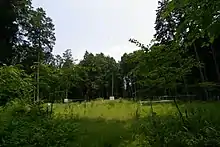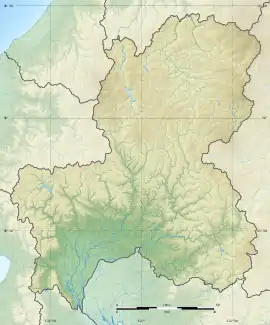Shōge temple ruins
Shōge temple ruins (正家廃寺跡, Shōge Haiji ato), is an archaeological site with the ruins of a late Hakuhō to early Heian period Buddhist temple located in what is now the city of Ena, Gifu, Japan. The temple no longer exists, but the temple grounds were designated as a National Historic Site by the Japanese government in 2001.[1]
| Shōge temple ruins | |
|---|---|
正家廃寺 | |
 Site of Shōge temple ruins | |
| Religion | |
| Affiliation | Buddhism |
| Location | |
| Location | Ena-shi, Gifu-ken |
| Country | |
 Shōge temple ruins  Shōge temple ruins (Japan) | |
| Geographic coordinates | 35°26′19″N 137°25′01″E |
History
The site is located on a hill at the southern edge of the Ena Basin at an elevation of 325 meters. Although the ruins of an abandoned temple have long been known to exist, there is no mention of the site in historic literature. The Ena City Board of Education commissioned an archaeological survey to the Nanzan University in 1977-1979 and again in 1993-1999. The survey found the foundations of several buildings and many pottery shards, from which the ruin was dated to the first half of the 8th century. The temple compound measured 110 meters east-west by 70 meters north-south, and the structures consisted of a Main Hall, Kō-dō (Lecture Hall), Pagoda, rectory, cloister, and several smaller structures in a layout almost identical to that of Hōryū-ji. No roof tiles were found, indicating that these buildings pre-dated the use of tiled roofs. Also, the layout and design of a storehouse was also highly unusual, with the only other structure known to have a similar arrangement having been discovered in the ruins at Asuka, Nara. Two pit dwellings were also identified, one of which may have been a smithy.
The temple appears to have gone into decline after a fire in the 9th century and to have disappeared by the early 10th century.
The foundation of the temple may be connected with the establishment of Ena District, which also occurred in the first have of the eighth century,
The site is located about 1.6 km south of Ena Station.
References
- "正家廃寺跡" (in Japanese). Agency for Cultural Affairs.
External links
| Wikimedia Commons has media related to Shoge-haiji. |